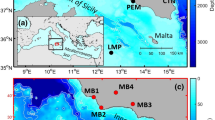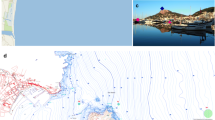Summary
The possibility of monitoring climate variability on decadal scales by means of microseisms is investigated. For this purpose, digital microseismic data from Hamburg (Germany) of the six winters 1992/93 to 1997/98 are compared with model ocean-wave fields of the North Atlantic. A correlation coefficient of aboutr= 0.7 was found between the linear ocean-wave amplitude at the Norwegian coast and the square-root of the microseismic amplitude. Considering monthly means of the energy of both ocean waves and microseisms the correlation exceedsr= 0.8 in special areas. A correlation coefficient ofr = 0.6 was found between the monthly winter index of the North Atlantic Oscillation (NAO) and the respectively averaged microseismic energy. Encouraged by these results, further investigations are planned for analysing earlier microseisms which has been recorded in Hamburg since 1905.
Zusammenfassung
Es wird untersucht, ob sich Klimaschwankungen mit Perioden um zehn Jahre aus Aufzeichnungen der Mikroseismik erfassen lassen. Zu diesem Zweck werden digitale Mikroseismikdaten der sechs Winter 1992/93 bis 1997/98 aus Hamburg mit Modelldaten des Seegangs im Nordatlantik verglichen. Es ergibt sich ein Korrelationskoeffizient vonr= 0,7 zwischen den mittleren linearen Amplituden des Seegangs an der norwegischen Küste und der Wurzel aus der Amplitude der Mikroseismik. Für monatliche Mittel der Energien des Seegangs und der Mikroseismik werden in einigen Gebieten Korrelationskoeffizienten über r= 0,8 gefunden. Der Korrelationskoeffizient zwischen dem monatlichen Index der nordatlantischen Oszillation (NAO) und der entsprechend gemittelten Energie der Mikroseismik beträgtr= 0,6. Ermutigt durch diese Ergebnisse sollen historische Registrierungen der Mikroseismik analysiert werden, die in Hamburg seit 1905 vorliegen.
Similar content being viewed by others
References
Barlow, L. K., White, J. W. C, Barry, R. G., Rogers, J. C., Grottes, P. M., 1993: The North Atlantic Oscillation signature in deuterium and deuterium excess signals in the Greenland Ice Sheet Project-2. Ice Core, 1840–1970.Geophys. Res. Letters,20, 2901–2904.
Behrens, A. and D. Schrader, 1994: The wave-forecast system of the ‘Deutscher Wetterdienst’ and the ‘Bundesamt für Seeschiffahrt und Hydrographie’: A verification using ERS-1 altimeter and scatterometer data.Dt. hydrogr.Z.,46, 131–149.
Cayan, D. R, 1992: Latent and sensible heat flux anomalies over the northern oceans: The connection to monthly atmospheric oscillation.J. Clim.,5, 354–369.
Friedrich, A., Krüger, F., Klinge, K., 1998: Ocean-generated microseismic noise located with the Gräfenberg array.Journ. of Seismol. 2, 47–64.
Hasselmann, K. A., 1963: Statistical analysis of the generation of microseisms.Reviews of Geophysics,1, 177–210.
Hurrell, J. W., 1995: Decadal trends in the North Atlantic Oscillation: Regional temperatures and precipitation.Science,269, 676–679.
Günther, H., Rosenthal, W., Weare, T. J., Worthington, B. A., Hasselmann, K., Ewing, J. A., 1979: A hybrid parametrical wave prediction model.J. Geophys. Res.,84, 5727–5738.
Gutenberg, B., 1924: Die seismische Bodenunruhe.Sammlung Geophysikalischer Schriften, 3, 67 pp., Berlin: Bornträger.
Koslowski, G. and P. Loewe, 1994: The western Baltic sea ice season in terms of mass-related severity index: 1879–1992. Part I. Temporal variability and association with the North Atlantic Oscillation.Tellus,46A, 66–74.
Longuett-Higgins, M. S., 1950: A theory of the origin of microseisms.Phil. Trans. Roy. Soc. London, Ser. A,243, 1–35.
Miche, M., 1944: Movements ondulatoires de la mer en profendeur constante ou decroissante.Ann. Ponts Chaussees,114, 25–87, 131–164, 270–292, 396–406.
Rogers, J. C, 1984: The association between the North Atlantic Oscillation and the Southern Oscillation in the northern hemisphere.Monthly Weather Review,12, 1999–2015.
Schmidt, H. and H. von Storch, 1993: German Bight storms analysed.Nature,365, 791.
Strobach, K., 1962: Ein Beitrag zum Problem der Entstehung und der Wellennatur der mikroseismischen Unruhe.Hamburger Geophysikalische Einzelschriften, 5, 125 pp.
Storch, H. von, Alexandersson, H., Bouws, E., Carretero, J. C, Gonzalez, I. L, Guddal, J., Günther, H., JanNINK, D., KHARIN, V., KOMEN, G., REICHARDT, H., Rosenthal, W., Ruiz de Elvira, A., Schmith, T., Stawarz, M., 1995: The WASA project: changing storm and wave climate in the Northeast Atlantic and adjacent seas? 4th International Workshop on Wave Hindcasting and Forecasting, Oct. 16–20, 1995, Banff (Canada), 31–44.
Author information
Authors and Affiliations
Rights and permissions
About this article
Cite this article
Essen, H.H., Klussmann, J., Herber, R. et al. Does microseisms in Hamburg (Germany) reflect the wave climate in the North Atlantic?. Deutsche Hydrographische Zeitschrift 51, 33–45 (1999). https://doi.org/10.1007/BF02763955
Received:
Accepted:
Published:
Issue Date:
DOI: https://doi.org/10.1007/BF02763955




